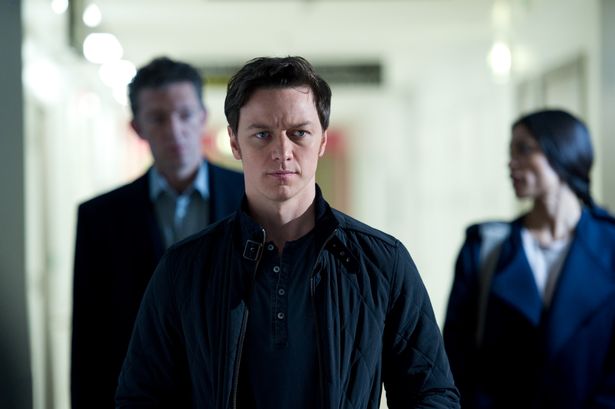Title: Trance
Fox Searchlight Pictures
Director: Danny Boyle
Screenwriter: Joe Ahearne, John Hodge
Cast: James McAvoy, Vincent Cassel, Rosario Dawson
Screened at: Dolby88, NYC, 3/25/13
Opens: April 5, 2013
No film in recent memory exceeds the implied product placement of the science of hypnotherapy as does Danny Boyle’s visually stunning and boldly hallucinatory “Trance.” The picture is about memory—loss of—and the attempt by a band of motivated people to restore the ability of an amnesiac to remember a crucial bit of information. It is also a terrific poster, if you will, for female empowerment, even if the empowered woman may be skirting the law.
A film that seems to beg multiple viewings, but one which may not reveal its complexity no matter how many times you see it, “Trance” follows Nicolas Roeg’s method of keeping the audience off guard, as seen in Roeg’s “Don’t Look Now,” which features a psychic who believes she can see the spirit of a drowned woman. It’s helps greatly that Boyle not only has a challenging and fascinating script from Joe Ahearne and John Hodge but a cast of three principals who are at the pinnacle of their acting powers and who play against each other exquisitely.
The action is seen through the eyes of Simon (James McAvoy), who serves as narrator and amnesiac, an auctioneer who sells off major works of art to the well-heeled but is also the inside man on a scheme to steal Goya’s painting “Witches’ Flight.” That work of art helped establish the Spanish artist’s rep as the first modern painter, in that he drew from inside a person’s subconscious mind. We learn that heavy measures are taken to secure the art works which are worth millions on a given day of auctioneering, but that thanks to Simon’s cooperation with a group of thieving professionals, a robbery takes place which could have been the perfect crime. Problem is that Simon, after hiding the Goya, is hit by a car and can no longer remember where he stashed the canvas, though at first, his accomplice Franck (Vincent Cassel) and a body of goons, are skeptical. When they realize Simon is telling the truth about his failed memory, they set him up with Elizabeth Lamb (Rosario Dawson), a hypnotherapist who promises the gang that she can get Simon to reveal the hiding place.
“Trance” is a dream-within-a-dream undertaking, keeping the audience so off balance and so inundated with twists and turns that guessing which scenes are reality and which are products of Simon’s unconscious mind are not only impossible but beside the point. A majorl aim of the film is to show off director Boyle’s vivid imagination in translating the printed page to the screen, his cinematographer, Anthony Dod Mantle, knocking out visual delights that take us from an imaginary ride in the country to a distant look at a motorway flooded with orange light. Much of the story seems to take place in the near future, though Boyle takes advantage of some keen flashbacks to clue us in at what’s going on in Simon’s mind, deliberately holding back on simple solutions.
Critics and general audience members will probably be divided on whether this lack of a straightforward narrative is a plus. Those of us with imaginations will welcome the seemingly endless diversions, while others will be frustrated trying to guess wildly at which of the action takes place in reality or in Simon’s mind. The film includes sexual tension (Franck and Simon compete for the carnal attentions of the therapist, who in one striking scene poses as though a subject of a Goya painting), showing us that Franck is a human being like the rest of us and not a simple, Philistine criminal. Rosario Dawson is lovely to look at, clothed and otherwise, displaying the charisma that one would expect of a successful pro following the field fathered by Franz Mesmer in the 18th Century.
Rated R. 104 minutes © 2013 by Harvey Karten, Member, New York Film Critics Online
Story – B+
Acting – A-
Technical – A-
Overall – A-

